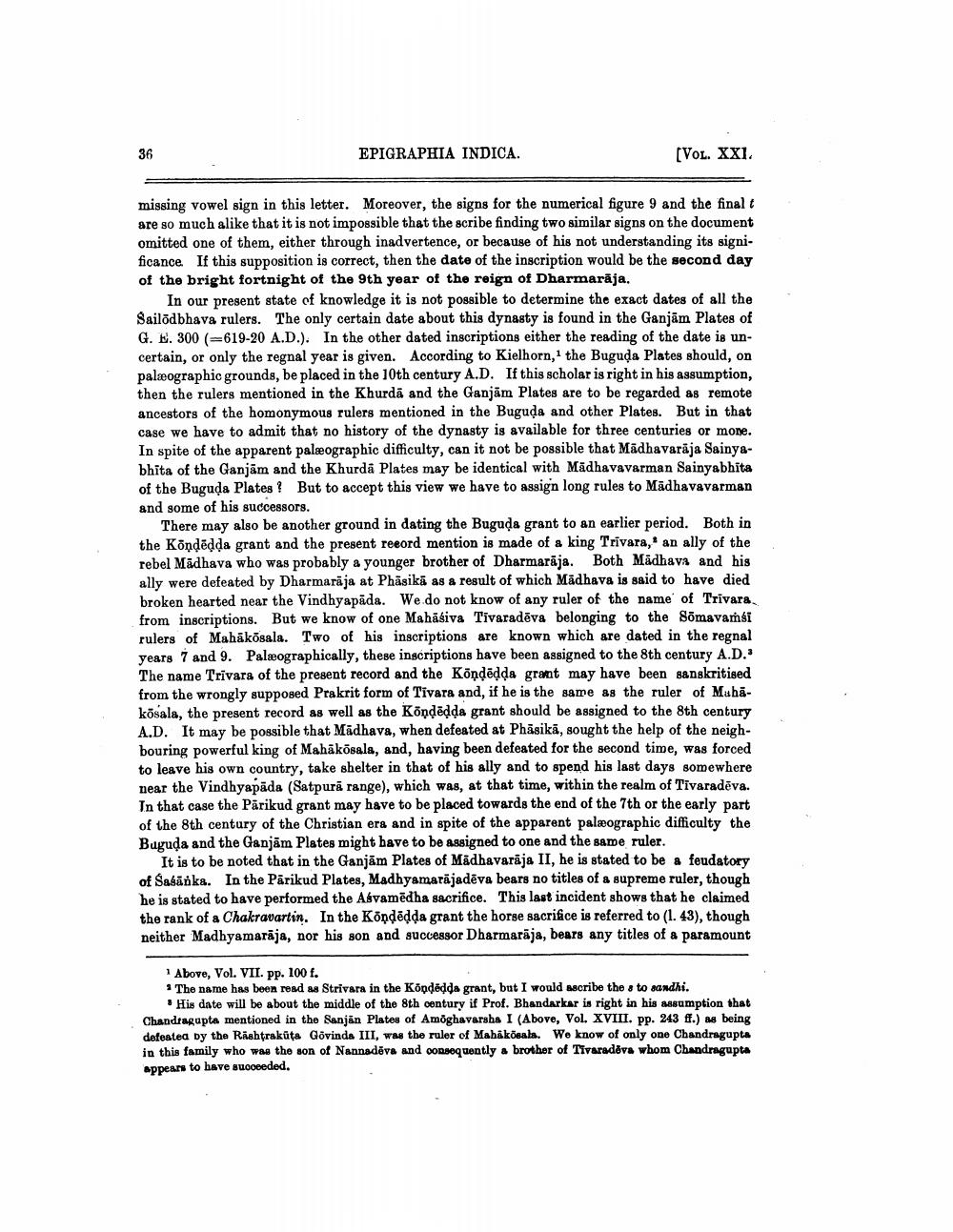________________
EPIGRAPHIA INDICA.
(Vol. XXI.
missing vowel sign in this letter. Moreover, the signs for the numerical figure 9 and the final are so much alike that it is not impossible that the scribe finding two similar signs on the document omitted one of them, either through inadvertence, or because of his not understanding its significance. If this supposition is correct, then the date of the inscription would be the second day of the bright fortnight of the 9th year of the reign of Dharmaraja.
In our present state of knowledge it is not possible to determine the exact dates of all the Sailodbhava rulers. The only certain date about this dynasty is found in the Ganjam Plates of G. E. 300 (-619-20 A.D.). In the other dated inscriptions either the reading of the date is uncertain, or only the regnal year is given. According to Kielhorn, the Buguda Plates should, on palæographic grounds, be placed in the 20th century A.D. If this scholar is right in his assumption, then the rulers mentioned in the Khurda and the Ganjām Plates are to be regarded as remote ancestors of the homonymous rulers mentioned in the Buguda and other Plates. But in that case we have to admit that no history of the dynasty is available for three centuries or more. In spite of the apparent palæographic difficulty, can it not be possible that Madhavarāja Sainyabhita of the Ganjam and the Khurda Plates may be identical with Madhavavarman Sainyabhita of the Buguda Plates ? But to accept this view we have to assign long rules to Madhavavarman and some of his successors.
There may also be another ground in dating the Buguda grant to an earlier period. Both in the Kõndēdda grant and the present reeord mention is made of a king Trivara,' an ally of the rebel Mādhava who was probably a younger brother of Dharmarāja. Both Madhava and his ally were defeated by Dharmarāja at Phäsikā as a result of which Mädhava is said to have died broken hearted near the Vindhyapäda. We do not know of any ruler of the name of Trivara from inscriptions. But we know of one Mahāśiva Tivaradēva belonging to the Sömavami rulers of Mahäkösala. Two of his inscriptions are known which are dated in the regnal years 7 and 9. Palmographically, these inscriptions have been assigned to the 8th century A.D." The name Trivara of the present record and the Köņdēdda grant may have been sangkritised from the wrongly supposed Prakrit form of Tivara and, if he is the same as the ruler of Muhäkösala, the present record as well as the Kõņdēdda grant should be assigned to the 8th century A.D. It may be possible that Mädhave, when defeated at Phāsikā, sought the help of the neighbouring powerful king of Mahäkösala, and, having been defeated for the second time, was forced to leave his own country, take shelter in that of his ally and to spend his last days somewhere near the Vindhyapada (Satpura range), which was, at that time, within the realm of Tivaradēva. In that case the Părikud grant may have to be placed towards the end of the 7th or the early part of the 8th century of the Christian era and in spite of the apparent palæographic difficulty the Buguda and the Ganjām Plates might have to be assigned to one and the same ruler.
It is to be noted that in the Ganjām Plates of Madhavarāja II, he is stated to be a feudatory of Sagāöka. In the Pärikud Plates, Madhyamarājadēva bears no titles of a supreme ruler, though he is stated to have performed the Abvamēdha sacrifice. This last incident shows that he claimed the rank of a Chakravartin. In the Köņdēdda grant the horse sacrifice is referred to (1. 43), though neither Madhyamarāja, nor his son and successor Dharmarāja, bears any titles of a paramount
1 Above, Vol. VII. pp. 100 f. • The name has been read as Strivara in the Köpdědda grant, but I would ascribe the sto sandhi.
. His date will be about the middle of the 8th century if Prof. Bhandarkar is right in his assumption that Chandragupta mentioned in the Sanjan Plates of Amöghavarsha I (Above, Vol. XVIII. pp. 243 ff.) as being defeated by the Rashtrakūta Govinda III, was the ruler of Mahakosala. We know of only one Chandragupta in this family who was the son of Nannadēvs and consequently a brother of Tivaradova whom Chandragupta appears to have succeeded.




